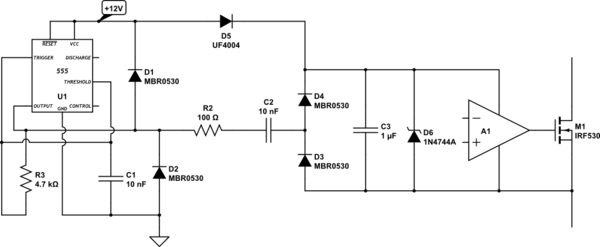In common terms (and, I don't know that there's a more complete / strict / technical definition; it doesn't seem it would matter that much, anyway):
A charge pump is an AC-DC or DC-DC conversion unit, distinguished by the use of capacitors and switches to step voltage up or down, typically by small integer ratios. Current handling is generally small, or efficiency poor, due to the capacitor reactance effectively adding with switch and other resistances to constitute voltage drop through the device.
A bootstrap circuit is anything where the traditional phrase "to pull one's self up by your bootstraps", i.e., where some element of the circuit (say, an amplifier) is made to reference its output, thus driving its input, or supply, or other elements, in the same direction; at least momentarily, as long as the bootstrapping element retains its state between cycles.
Clearly, one cannot pull up on their bootstraps forever (or, well, at all, as is the point of the original phrase), so implicit in this application is a time constant, such as how much time the element takes to discharge into the connected circuit.
Typically a capacitor is used to bootstrap a voltage; I suppose an inductor could be used to bootstrap a current just as well, but that's a far less common application.
Since time is of the essence, bootstrapping is typical where cycling, or a return to quiescent conditions, happens regularly. Examples are half-bridge switching circuits (where the low side is always switching alternately with the high side), and amplifiers for various purposes (some early transistorized audio amplifiers saved on then-expensive transistors by replacing a constant-current source with a pull-up resistor, bootstrapped to the output with a relatively large-value capacitor called the "Q capacitor", I suppose because it improved the "quality" of the circuit?).
These are separate applications / perspectives, but there is some overlap. Particularly in the switching circuit (half-bridge inverter), they overlap: the bootstrap is, in a sense, "pumping" charge from the low side to the high side. The difference is, unlike a DC-DC charge pump as such, there is no output rail; the purpose is not to obtain a "VCC + 12V" rail, but to have 12V locally available for the high side regardless of its common-mode (i.e. the MOSFET source) voltage.
So we might not call a bootstrap gate drive circuit a "charge pump" as such.
But we can intentionally "pump" charge to the high side, in the event that switching isn't occurring regularly. In this case, we have an AC source located near ground (or, really, anywhere), then connect a series capacitor from the source to the high-side supply. The capacitor gets rectified by clamp diodes, making a "half-wave voltage doubler" circuit (which in this case isn't really "doubling" at all, it's merely copying the peak-to-peak voltage from the low side -- which is to say, merely its supply voltage, no more), and this maintains the high-side drive circuitry in the absence of switching, or an active low-side switch.

simulate this circuit – Schematic created using CircuitLab
A complete system might look like this. Assuming the MOS source pin voltage is clamped to near GND (i.e. by a low-side MOSFET's body diode, or a flyback clamp diode). Note that, C2 pumps regardless of who (which side) is doing the pumping. As M1 switches on and off, it can deliver many times more charge than the 555 itself does. This would overcharge the bootstrap rail, thus a zener/TVS shall be used to limit voltage to a safe operating level for the MOSFET driver.
The dV/dt (rate of voltage change) can likewise be very high -- suppose the output switches in some 10s of ns, what happens then?! This would draw huge peak currents through C2, hence a series resistor has been added to limit that current, and clamp diodes to protect the 555.
In the event the output is switching regularly, D5 also supplies bootstrap power the normal way. Which itself may want a modest series resistor, to limit startup current, to deal with undershoot/ringing, etc.
Due to the current passing through C2, this strategy is only effective up to modest ratios of supply voltages, that is between gate supply (12V here) and the switching voltage. I've done up to 100V (at 140 kHz) this way before, which was fine, but the design parameters don't look appealing much above there, and I think I would recommend a DC-DC converter for more.
If you can guarantee a slower switching (edge) rate, the voltage ratio can be higher before running into wasted power / component ratings concerns. A slow DC on/off switch, commutating in some 10 µs or so, might be good to a couple hundred volts.
Higher voltages also incur concerns about peak voltages over stray inductances; even at slow rates of change. (And particularly at high currents; consider 100A, or 1000A, commutating in 10µs!). In these cases, total DC isolation may be desirable.


